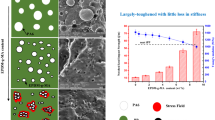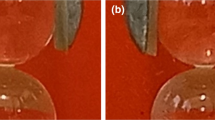Abstract
The advent of the Three-Dimensional (3D) printing technique, as an Additive Manufacturing technology, made the manufacture of complex porous scaffolds plausible in the tissue engineering field. In Fused Deposition Modeling based 3D printing, layer upon layer deposition of filaments produces voids and gaps, leading to a crack generation and loose bonding. Cohesive zone model (CZM), a fracture mechanics concept, is a promising theory to study the layers bond behavior. In this paper, a combination of experimental and computational investigations was proposed to obtain bond parameters and evaluate the effect of porosity and microstructure on these parameters. First, we considered two different designs for scaffolds beside a non-porous Bulk design. Then, we performed Double cantilever beam and Singe Lap Shear tests on the 3D printed samples for Modes I and II, respectively. Afterward, we developed the numerical simulations of these tests using the Finite element method (FEM) to obtain CZM bond parameters. Results demonstrate that the initial stiffness and cohesive strength were pretty similar for all designs in Mode I. However, the cohesive energy for the Bulk sample was approximately four times of porous samples. Furthermore, for Mode II, the initial stiffness and cohesive energy of the Bulk model were five and four times of porous designs while their cohesive strengths were almost the same. Also, using cohesive parameters was significantly enhanced the accuracy of FEM predictions in comparison with fully bonded assumption. It can be concluded that for the numerical analysis of 3D printed parts mechanical behavior, it is necessary to obtain and suppose the cohesive parameters. The present work illustrates the effectiveness of CZM and FEM combination to obtain the layer adhesive parameters of the 3D printed scaffold.












Similar content being viewed by others
Data availability
Yes, the data and material are available.
Code availability
Yes, the code is available.
References
Soufivand AA et al (2020) Prediction of mechanical behavior of 3D bioprinted tissue-engineered scaffolds using finite element method (FEM) analysis. Addit Manuf 33:101181
Koch C, Van Hulle L, Rudolph N (2017) Investigation of mechanical anisotropy of the fused filament fabrication process via customized tool path generation. Addit Manuf 16:138–145
Standard A (2012) Standard terminology for additive manufacturing technologies. ASTM International F2792–12a
Isakov D et al (2016) 3D printed anisotropic dielectric composite with meta-material features. Mater Des 93:423–430
Soufivand AA et al (2020) The effect of 3D printing on the morphological and mechanical properties of polycaprolactone filament and scaffold. Polym Adv Technol 31(5):1038–1046
Naghieh S et al (2016) Numerical investigation of the mechanical properties of the additive manufactured bone scaffolds fabricated by FDM: the effect of layer penetration and post-heating. J Mech Behav Biomed Mater 59:241–250
Naghieh S et al (2016) Fused deposition modeling and fabrication of a three-dimensional model in maxillofacial reconstruction. Regen Reconstr Restor 1(3):139–144
Boccardi E et al (2015) Oxygen diffusion in marine-derived tissue engineering scaffolds. J Mater Sci - Mater Med 26(6):200
Sherwood JK et al (2002) A three-dimensional osteochondral composite scaffold for articular cartilage repair. Biomaterials 23(24):4739–4751
Felfel R et al (2016) In vitro degradation and mechanical properties of PLA-PCL copolymer unit cell scaffolds generated by two-photon polymerization. Biomed Mater 11(1):015011
Serra T et al (2014) Relevance of PEG in PLA-based blends for tissue engineering 3D-printed scaffolds. Mater Sci Eng C 38:55–62
Tyler B et al (2016) Polylactic acid (PLA) controlled delivery carriers for biomedical applications. Adv Drug Deliv Rev 107:163–175
Senatov FS et al (2016) Mechanical properties and shape memory effect of 3D-printed PLA-based porous scaffolds. J Mech Behav Biomed Mater 57:139–148
Tayton E et al (2014) A comparison of polymer and polymer–hydroxyapatite composite tissue engineered scaffolds for use in bone regeneration. An in vitro and in vivo study. J Biomed Mater Res Part A 102(8):2613–2624
Grémare A et al (2018) Characterization of printed PLA scaffolds for bone tissue engineering. J Biomed Mater Res Part A 106(4):887–894
Martínez J et al (2013) Comparative between FEM models for FDM parts and their approach to a real mechanical behaviour. Procedia Eng 63:878–884
Park S-I, Watanabe N, Rosen DW (2018) Estimating failure of material extrusion truss structures based on deposition modeling and a cohesive zone model. Mater Des 147:122–133
Wang J et al (2016) A novel approach to improve mechanical properties of parts fabricated by fused deposition modeling. Mater Des 105:152–159
Barenblatt GI (1962) The mathematical theory of equilibrium cracks in brittle fracture. Adv Appl Mech 7(1):55–129
Dugdale DS (1960) Yielding of steel sheets containing slits. J Mech Phys Solids 8(2):100–104
Turon A et al (2007) An engineering solution for mesh size effects in the simulation of delamination using cohesive zone models. Eng Fract Mech 74(10):1665–1682
Camanho PP, Davila CG, De Moura M (2003) Numerical simulation of mixed-mode progressive delamination in composite materials. J Compos Mater 37(16):1415–1438
Schellekens J, De Borst R (1991) Numerical simulation of free edge delamination in graphite-epoxy laminates under uniaxial tension. Composite structures. Springer, pp 647–657
Standard, A (2007) D5528–01,“Standard test method for Mode I Interlaminar Fracture Toughness of Unidirectional Fiber-Reinforced Polymer Matrix Composites,” ASTM International, West Conshohocken, PA, https://doi.org/10.1520/D5528-94A
Valoroso N, Fedele R (2010) Characterization of a cohesive-zone model describing damage and de-cohesion at bonded interfaces. Sensitivity analysis and mode-I parameter identification. Int J Solids Struct 47(13):1666–1677
Gustafson PA, Waas AM (2009) The influence of adhesive constitutive parameters in cohesive zone finite element models of adhesively bonded joints. Int J Solids Struct 46(10):2201–2215
Maier G, Bocciarelli M, Fedele R (2005) Some innovative industrial prospects centered on inverse analyses. Parameter identification of materials and structures. Springer, pp 55–93
Oh J-C, Kim H-G (2013) Inverse estimation of cohesive zone laws from experimentally measured displacements for the quasi-static mode I fracture of PMMA. Eng Fract Mech 99:118–131
Wang J et al (2010) Viscoelastic adhesive interfacial model and experimental characterization for interfacial parameters. Mech Mater 42(5):537–547
Bocciarelli M, Bolzon G (2009) Indentation and imprint mapping for the identification of interface properties in film-substrate systems. Int J Fract 155(1):1–17
Kishore V et al (2017) Infrared preheating to improve interlayer strength of big area additive manufacturing (BAAM) components. Addit Manuf 14:7–12
Spoerk M et al (2017) Parametric optimization of intra-and inter-layer strengths in parts produced by extrusion-based additive manufacturing of poly (lactic acid). J Appl Polym Sci 134(41):45401
Seppala JE et al (2017) Weld formation during material extrusion additive manufacturing. Soft Matter 13(38):6761–6769
Liravi F, Das S, Zhou C (2015) Separation force analysis and prediction based on cohesive element model for constrained-surface Stereolithography processes. Comput Aided Des 69:134–142
Ahmadi A et al (2016) Effect of manufacturing parameters on mechanical properties of 316L stainless steel parts fabricated by selective laser melting: a computational framework. Mater Des 112:328–338
Spackman CC, et al. (2018) A cohesive zone model for the stamping process encountered during three-dimensional printing of fiber-reinforced soft composites. J Manuf Sci Eng. 140(1).
Fonseca J et al (2019) Study of the interlaminar fracture under mode I loading on FFF printed parts. Compos Struct 214:316–324
Kumar S, Wardle BL, Arif MF (2017) Strength and performance enhancement of bonded joints by spatial tailoring of adhesive compliance via 3D printing. ACS Appl Mater Interfaces 9(1):884–891
Kovan V, Altan G, Topal ES (2017) Effect of layer thickness and print orientation on strength of 3D printed and adhesively bonded single lap joints. J Mech Sci Technol 31(5):2197–2201
Garcia R, Prabhakar P (2017) Bond interface design for single lap joints using polymeric additive manufacturing. Compos Struct 176:547–555
Falck R et al (2018) AddJoining: a novel additive manufacturing approach for layered metal-polymer hybrid structures. Mater Lett 217:211–214
Dugbenoo E et al (2018) Enhanced bonding via additive manufacturing-enabled surface tailoring of 3D printed continuous-fiber composites. Adv Eng Mater 20(12):1800691
Yeo MG, Kim GH (2012) Preparation and characterization of 3D composite scaffolds based on rapid-prototyped PCL/β-TCP struts and electrospun PCL coated with collagen and HA for bone regeneration. Chem Mater 24(5):903–913
Farah S, Anderson DG, Langer R (2016) Physical and mechanical properties of PLA, and their functions in widespread applications—A comprehensive review. Adv Drug Deliv Rev 107:367–392
Funding
This research did not receive any specific grant from funding agencies in the public, commercial, or not-for-profit sectors.
Author information
Authors and Affiliations
Contributions
NN: Investigation, Formal analysis, Software, Writing Original Draft, Data Curation AAS: Conceptualization, Methodology, Draft Review and Editing, Visualization, Supervision NA: Conceptualization, Resources, Project administration.
Corresponding authors
Ethics declarations
Conflict of interest
The authors have no relevant financial or non-financial interests to disclose.
Ethical approval
Not applicable.
Consent to participate
Not applicable.
Consent for publication
Not applicable.
Additional information
Publisher's Note
Springer Nature remains neutral with regard to jurisdictional claims in published maps and institutional affiliations.
Rights and permissions
About this article
Cite this article
Nazemzadeh, N., Soufivand, A.A. & Abolfathi, N. Computing the bond strength of 3D printed polylactic acid scaffolds in mode I and II using experimental tests, finite element method and cohesive zone modeling. Int J Adv Manuf Technol 118, 2651–2667 (2022). https://doi.org/10.1007/s00170-021-08124-w
Received:
Accepted:
Published:
Issue Date:
DOI: https://doi.org/10.1007/s00170-021-08124-w




